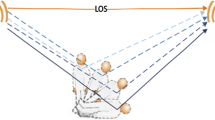Abstract
Location Estimation has become important for many applications of indoor wireless networks. Received Signal Strength (RSS) fingerprinting methods have been widely used for location estimation. Most of the location estimation system suffers with the problem of scalability and unavailability of all the access points at all the location for large site. The accuracy and response time of estimation are critical issues in location estimation system for large sites. In this paper, we have proposed a distributed location estimation method, which divide the location estimation system into subsystems. Our method partitions the input signal space and output location space into clusters on the basis of visibility of access points at various locations of the site area. Each cluster of input signal space together with output location subspace is used to learn the association between RSS fingerprint and their respective location in a subsystem. We have performed experimentation on two RSS dataset, which are gathered on different testbeds, and compared our results with benchmark RADAR method. Experimental results show that our method provide better results in terms of accuracy and response time in comparison to centralized systems, in which a single system is used for large site.
Similar content being viewed by others
References
Liu H., Darabi H., Banerjee P., Liu J. (2007) Survey of wireless indoor positioning techniques and systems. IEEE Transactions on Systems, Man, and Cybernetics, Part C: Applications and Reviews 37(6): 1067–1080
Ahmad, U., Gavrilov, A., Lee, S., & Lee, Y. (2008). A modular classification model for received signal strength based location systems. Neuro Computing, 71(13–15), 2669.
Bahl, P., & Padmanabhan, V. (2000). RADAR: An in-building RF-based user location and tracking system. In Proceedings of 19th IEEE annual joint conference of computer and communications societies, INFOCOM 2000 (Vol. 2, pp. 775–784).
Krishnan, P., Krishnakumar, A., Ju, W.H., Mallows, C., & Gamt, S. (2004). A system for lease: location estimation assisted by stationary emitters for indoor rf wireless networks. In Proceedings of 23rd IEEE annual joint conference of computer and communications societies, INFOCOM 2004 (Vol. 2, pp. 1001–1011). doi:10.1109/INFCOM.2004.1356987.
Youssef, M., Agrawala, A., & Udaya Shankar, A. (2003). Wlan location determination via clustering and probability distributions. In Proceedings of the first IEEE international conference on pervasive computing and communications, (PerCom 2003) (pp. 143–150). IEEE.
Michaelides M., Panayiotou C. (2009) Snap: Fault tolerant event location estimation in sensor networks using binary data. IEEE Transactions on Computers 58(9): 1185–1197. doi:10.1109/TC.2009.60
Bahl, P., Padmanabhan, V., & Balachandran, A. (2000). Enhancements to the RADAR user location and tracking system. Microsoft Research, (MSR-TR-2000-12) pp. 13.
Battiti, R., Nhat, T., & Villani, A. (2002). Location-aware computing: a neural network model for determining location in wireless LANs. Technical Report DIT-02-083, Ingegneria e Scienza dell’Informazione, University of Trento.
Pahlavan K., Li X., Makela J. (2002) Indoor geolocation science and technology. IEEE Communications Magazine 40(2): 112–118. doi:10.1109/35.983917
Youssef M., Agrawala A. (2008) The Horus location determination system. Wireless Networks 14(3): 357–374
Ahmad U., Gavrilov A., Lee Y., Lee S. (2008) Context-aware, self-scaling Fuzzy ArtMap for received signal strength based location systems. Soft Computing-A Fusion of Foundations, Methodologies and Applications 12(7): 699–713
Chen, C. (2005). Hybrid location estimation and tracking system for mobile devices. In Proceedings of 61st IEEE vehicular technology conference, VTC 2005 (Vol. 4, pp. 2648–2652).
Ding, X., Li, H., Li, F., & Wu, J. (2008). A novel infrastructure WLAN locating method based on neural network. In Proceedings of 4th Asian conference on internet engineering (pp. 47–55).
Gupta, A., Tapaswi, & S., Jain, V. (2009). Recurrent grid based voting approach for location estimation in wireless sensor networks. In Proceedings of symposia and workshops on ubiquitous, autonomic and trusted computing, UIC-ATC’09 (pp. 263–267).
Yang B., Xu J., Yang J., Li M. (2010) Localization algorithm in wireless sensor networks based on semi-supervised manifold learning and its application. Cluster Computing 13(4): 435–446
Jain, V., Tapaswi, S., & Shukla, A. (2010). Distributed growing radial basis function neural networks for location estimation in indoor wireless networks. In 6th International conference on wireless communications networking and mobile computing (WiCOM) (pp. 1–6). doi:10.1109/WICOM.2010.5601059.
Hightower J., Borriello G. (2001) Location systems for ubiquitous computing. Computer 34(8): 57–66
Laoudias, C., Michaelides, M., & Panayiotou, C. (2011). Fault tolerant fingerprint-based positioning. In IEEE international conference on communications (ICC) (pp. 1–5). doi:10.1109/icc.2011.5963136.
Qiang Yang Sinno Jialin Pan, V.W.Z. (2007). IEEE ICDM Data Mining Contest 2007. http://www.cse.ust.hk/~qyang/ICDMDMC07/. Accessed 20 April 2011.
Author information
Authors and Affiliations
Corresponding author
Rights and permissions
About this article
Cite this article
Jain, V.K., Tapaswi, S. & Shukla, A. Performance Analysis of Received Signal Strength Fingerprinting Based Distributed Location Estimation System for Indoor WLAN. Wireless Pers Commun 70, 113–127 (2013). https://doi.org/10.1007/s11277-012-0682-7
Published:
Issue Date:
DOI: https://doi.org/10.1007/s11277-012-0682-7




